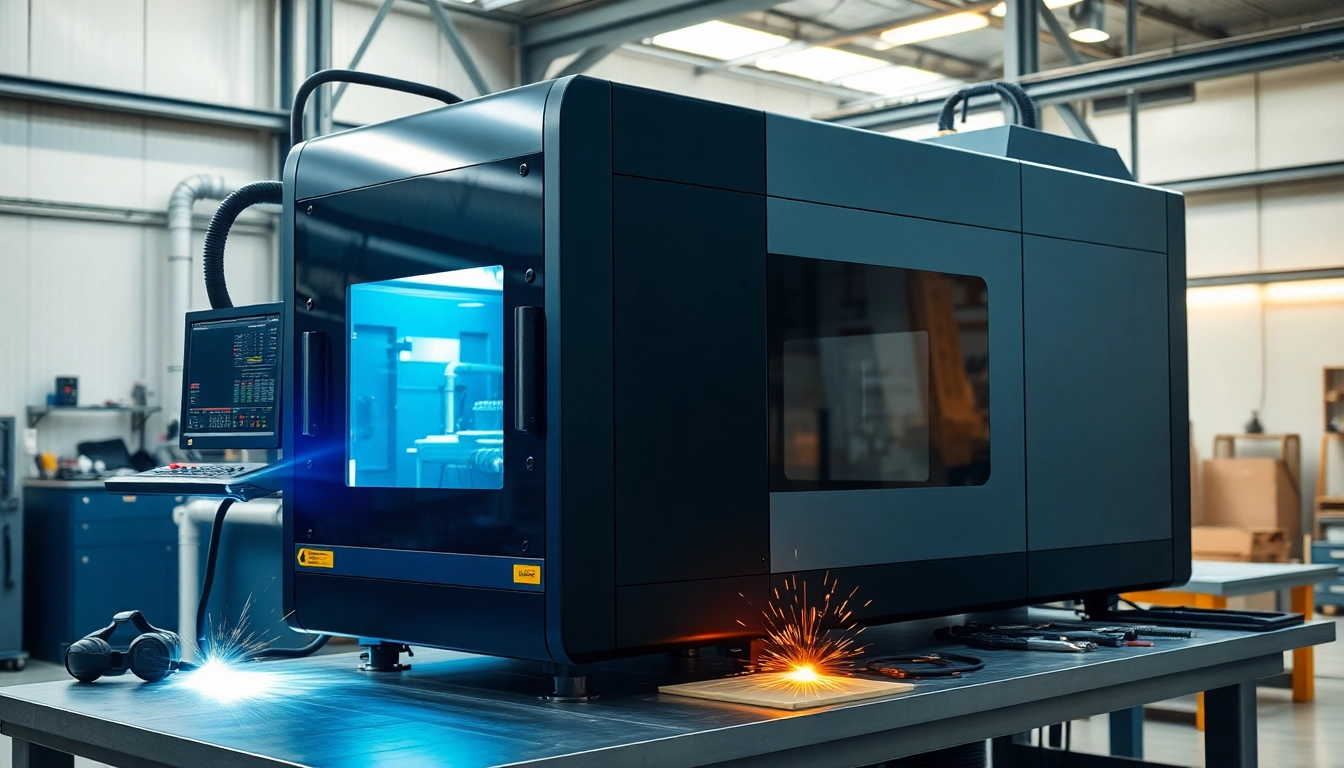Introduction to Laser Welding Machine Technology
Laser welding technology has revolutionized the way industries approach joining processes. Utilizing focused laser beams, this method achieves high precision and efficiency, making it an essential tool in various sectors, from automotive to electronics. The Laser welding machine facilitates seamless metal fusion while minimizing the heat-affected zone, reducing warping and ensuring a cleaner finish compared to traditional welding techniques. As industries continue to evolve, understanding the intricacies of laser welding is crucial for professionals seeking to stay ahead in a competitive market.
Understanding the Basics of Laser Welding
At its core, laser welding is a process that uses concentrated light emitted from a laser to join materials, primarily metals. This technique takes advantage of the unique properties of laser light, particularly its ability to focus on a very small area while delivering a significant amount of energy. When the laser beam strikes the workpiece, it melts the material, allowing two pieces to be fused together as they cool. This process can be highly controlled, making it suitable for delicate components that require a great deal of precision.
Lasers used in welding can be categorized into different types, each suited to specific applications. Continuous wave lasers are often used for thick materials, while pulsed lasers are ideal for thin sheets, particularly in the automotive and electronics industries. The ability to adjust the power and speed of the laser beam enhances the versatility of the laser welding machine, allowing engineers to tailor the process to their specific needs.
Advantages of Using Laser Welding Machines
- Precision: The focused nature of the laser allows for incredibly precise welds, accommodating the smallest of components with minimal distortion.
- Speed: Laser welding can significantly speed up production times, as it can be automated and performed much faster than traditional methods.
- Energy Efficiency: Lasers are more energy-efficient than other welding methods, reducing overall operational costs.
- Minimal Heat Affected Zone (HAZ): The concentrated heat minimizes the area impacted, preserving the integrity of surrounding materials and components.
- Versatility: Laser welding can be applied to various materials and thicknesses, expanding its applicability across different industries.
Applications Across Industries with Laser Welding Machines
Laser welding machines find applications across numerous fields, reflecting their versatility and effectiveness. In the automotive industry, they are used to join body panels and components, providing a robust bond while maintaining a lightweight structure. The ability to operate effectively on various materials, including steel and aluminum, makes laser welding crucial in vehicle manufacturing.
Similarly, in electronics, laser welding is employed to assemble components such as connectors and circuit boards, where precision is paramount. Its application in medical device manufacturing, where sterile and minimally invasive methods are required, demonstrates the technology’s significance in adhering to strict industry regulations. Furthermore, the aerospace sector benefits from laser welding for aircraft parts, where safety and durability are critical.
Choosing the Right Laser Welding Machine
Key Features to Look for in a Laser Welding Machine
Selecting the right laser welding machine is essential for optimal production performance. Key features to consider include:
- Wattage: The power of the laser is crucial; higher wattage enables welding through thicker materials.
- Beam Quality: A high-quality beam is essential for precision welding, minimizing defects and ensuring strong joint integrity.
- Cooling System: An efficient cooling system reduces downtime and protects the machine from overheating during prolonged use.
- Automation Capabilities: Machines that facilitate automation can significantly improve production rates and consistency.
- Software Control: Advanced software allows for precise control over the welding process, enabling operators to customize settings for different materials and applications.
Comparative Analysis of Laser Welding Machine Types
There are several types of laser welding machines, each designed for specific applications:
- Fiber Lasers: Known for high efficiency and versatility, fiber lasers are suitable for a broad range of materials, offering high beam quality and low operational costs.
- Diode Lasers: These lasers are often used for low-power applications and can be integrated into automated systems, providing flexibility and ease of use.
- CO2 Lasers: Though less common for welding due to lower efficiency compared to fiber lasers, CO2 lasers are often used for cutting and engraving; however, they can also be applied in specific welding scenarios.
- YAG Lasers: YAG lasers are suitable for more complex welding tasks and can handle thicker materials, making them a preferred choice for specific industrial applications.
Budget Considerations for a Laser Welding Machine
Investing in a laser welding machine requires careful budgeting, as costs can vary significantly based on the machine’s features, type, and capabilities. It’s essential to evaluate the total cost of ownership, which includes not only the initial purchase price but also maintenance, operational costs, and potential downtime.
While it may be tempting to opt for the cheapest option, it is crucial to consider the long-term implications of such a decision. Cheaper machines may lead to higher maintenance costs or less reliable performance, resulting in production delays. Conversely, a well-chosen laser welding machine can lead to increased efficiency, reduced waste, and ultimately higher profits.
Operational Best Practices for Laser Welding Machines
Preparation and Setup for Optimal Performance
Proper preparation and setup are vital in ensuring optimal performance from a laser welding machine. This includes:
- Calibration: Regular calibration of the machine guarantees that it is operating at the desired specifications and settings. This includes checking the laser alignment and intensity.
- Material Inspection: Inspecting materials before welding ensures they are free of contaminants and flaws that could affect weld quality.
- Focus Adjustment: Laser focus should be adjusted according to the material thickness and type to ensure optimal energy transfer.
- Workstation Safety: Ensure that the welding area is free from any obstructions and that proper ventilation is in place, especially when working with fumes.
Safety Protocols when Using Laser Welding Machines
Safety is paramount when operating a laser welding machine. Key safety protocols include:
- Personal Protective Equipment (PPE): Operators should wear appropriate PPE, including laser safety goggles, gloves, and protective clothing to shield against radiation and heat.
- Emergency Procedures: Familiarity with emergency shut-off procedures and protocols in case of accidents is essential for operator safety.
- Signage and Alerts: Proper signage should be displayed around the welding area to inform personnel about potential hazards associated with laser operations.
- Training Programs: Regular training sessions for operators on safe equipment handling and emergency responses are vital to maintain a safe working environment.
Maintenance Tips to Extend the Life of Your Laser Welding Machine
Regular maintenance is crucial for extending the lifespan of a laser welding machine. Here are some key maintenance tips:
- Routine Cleaning: Regularly clean optical components and the welding head to ensure optimal performance and prevent contamination.
- Check Wear Parts: Inspect and replace wear parts as needed, such as lenses and mirrors, to maintain beam quality.
- Cooling System Maintenance: Ensure the cooling system is functioning correctly to prevent overheating, which can lead to machine damage.
- Software Updates: Keep the machine’s software updated to benefit from improvements and new features that enhance performance.
Advanced Techniques in Laser Welding
Innovative Methods to Enhance Welding Quality
To achieve exceptional results in laser welding, operators can employ various innovative techniques:
- Hybrid Welding: Combining laser welding with traditional methods like TIG or MIG can enhance the quality and capabilities of the weld, particularly in complex applications.
- Multi-Pass Welding: For thicker materials, utilizing a multi-pass approach can ensure the weld penetrates deeply and achieves strong bonds without compromising integrity.
- Control of Ambient Conditions: Maintaining controlled environments during welding can significantly influence weld quality, reducing the likelihood of contaminants affecting the outcome.
Utilizing Automation with Your Laser Welding Machine
Integrating automation into the laser welding process can significantly improve efficiency and consistency. Automation can take various forms, including:
- Robotic Arms: Implementing robotic systems can provide precise movement and repetition, enhancing the speed and accuracy of welding operations.
- Automated Inspection Systems: Coupling laser welding with inspection technology enables real-time quality checks, ensuring defects are caught early in the production process.
- Adaptive Control Systems: Adaptive systems can adjust parameters in real-time based on immediate feedback, optimizing the welding process on-the-fly.
Performance Metrics: Measuring Welding Success
To assess the success of laser welding operations, various performance metrics must be employed:
- Weld Quality: Evaluate the physical characteristics of the weld, including strength, integrity, and visual appearance, to determine if it meets quality standards.
- Production Speed: Measure the amount of time taken to complete welds within a given timeframe to identify potential efficiencies.
- Material Integrity: Assess the heat-affected zone and look for any signs of warping or structural changes that could compromise the final product.
- Operational Downtime: Tracking downtime due to maintenance or failures can provide insights into the reliability and efficiency of the machine.
Future Trends in Laser Welding Machine Technology
Emerging Technologies Impacting Laser Welding
The future of laser welding is being shaped by emerging technologies that enhance capabilities and expand applications. Noteworthy trends include:
- Artificial Intelligence (AI): The application of AI in monitoring and optimizing laser welding processes can lead to increased efficiency and reduced human error.
- Machine Learning: Utilizing machine learning algorithms to predict equipment failures or optimize settings based on historical data will improve operation stability.
- Augmented Reality (AR): AR can assist operators in visualizing the laser path and settings in real-time, helping to ensure precision and accurate adjustments.
Sustainability in Laser Welding Practices
Sustainability is becoming increasingly important in manufacturing processes, and laser welding machines are no exception. By reducing material waste, energy consumption, and emissions, laser welding contributes to greener industrial practices. Emphasizing eco-friendly practices can include:
- Material Efficiency: The precision of laser welding leads to less thermal distortion and continued use of scrap materials.
- Energy Reduction: Developing more energy-efficient systems and incorporating renewable energy sources into operations can reduce the overall carbon footprint of manufacturing facilities.
- Recyclability: Designing components for easy dismantling and recycling can further enhance sustainability efforts.
Preparing for the Future of Laser Welding Applications
As laser welding technology continues to advance, industries must be proactive in preparing for its future applications. Staying informed about technological advancements, investing in training programs, and fostering a culture of innovation will equip organizations to thrive in an evolving landscape. Understanding market demands and adapting processes accordingly will ensure organizations remain competitive, as they leverage the escalating potential of Laser welding machines in driving manufacturing excellence.



